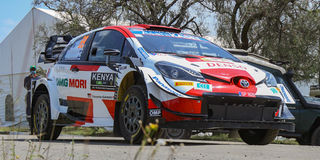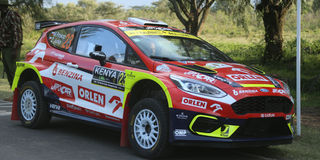‘Shakedown’ launches WRC Safari Rally action

Toyota Gazoo Racing’s Kalle Rovenperra, navigated by Jonne Halttunen, drive their car into the Service Park at the Kenya Wildlife Service Training Institute on June 22, 2021.
What you need to know:
- All the competitors must make provision in their cars for the installation of the FIA Safety Tracking System and FIA Safety Emergency Console.
- Apart from the Super Spectator Stage at Kasarani and the last stage at Malewa, all the other eight stages will be done twice on each of the three days of the competition.
- The longest spectator stage will be the Kedong Section which will be 32 kilometres while the SSS at Kasarani will be 5.15-kilometres.
The WRC Safari Rally will kick off Wednesday afternoon with the Shakedown at the Ndulele Conservancy off Moi Road in Naivasha.
The session will only be for the top priority drivers from the World Rally Championship (WRC) group and those other competitors who had made a special request to tackle the 5.15-kilometre section by the outskirts of Naivasha.
At the Shakedown, all the top priority drivers and those who had requested, will be required to complete their first passage of Shakedown in order of championship classification, and at an interval as determined by the organiser in consultation with the International Automobile Federation (FIA) and the WRC Promoter.
After the completion of the official stage, all drivers will gather in Nairobi in readiness for the official reconnaissance of the Super Spectator Stage (SSS) at Kasarani tomorrow morning.
The drivers will be allowed to do the recce in their proper rally cars.
From here the cars will head for the Kenyatta International Convention Centre (KICC) for an overnight rest halt before they are flagged on Friday morning for the official start of the sixth round of the 2021 World Rally Championship.
The rally proper will rev off from the Kenyatta International Conference Centre on Friday.
A total of 19 competitive stages will be run in the WRC Safari Rally, a round of the 2021 World Rally Championship.

M Sport Ford World Rally team's Martin Prokop navigated by Vicktor Chytka car at the service park on June 22, 2021.
The following stages will then be used for the action over the next three days:
Friday: Chui Lodge 13km, Kedong 32km, Oserian 18km.
Saturday: Elementaita 15km, Soysambu 20km, Sleeping Warrior 30km.
Sunday: Loldia 11km, Hells Gate 10km, Malewa 9km.
While all the stages will be done twice, Malewa Section will only be tackled only once on Sunday.
Drivers completed the official reconnaissance of the route of the rally yesterday. While the crews were out on the stages checking the route of the major event, members of the service crews were busy presenting their rally cars for the Scrutineering of the machines at the main Kenya Wildlife Services headquarters in Naivasha.
A Scrutineer’s job is to check that competing vehicles comply with the relevant technical regulations, which help to ensure safety and fair play.
At scrutineering competitors must produce all items of clothing including helmets and head restraints intended to be used according to the FIA Rules.
All the competitors must make provision in their cars for the installation of the FIA Safety Tracking System and FIA Safety Emergency Console.
Apart from the Super Spectator Stage at Kasarani and the last stage at Malewa, all the other eight stages will be done twice on each of the three days of the competition.
The longest spectator stage will be the Kedong Section which will be 32 kilometres while the SSS at Kasarani will be 5.15-kilometres.
High Class drivers
Meanwhile, Kenya’s Aakhif Virani hopes to finish in the top-20 despite the presence of high Class drivers from the World Rally Championship contenders.
“Our expectations are to finish in the top 20 overall as the entry list is huge and the WRC Rally cars are faster than our machine.
“For our class we hope to have a top 10 and perhaps a podium in our division,” Virani told Nation Sport.
“Preparations went well with our engineer over from UK and he went through the car and also dialed in some new settings from the recent two tests we had done. The car looks to be performing well in the tests and we are looking forward to driving it.”
Virani, who is patterned his regular navigator, Azhar Bhatti, will is in a Skoda Fabia R5 WRC 3 rally car.
This is Virani’s 13th Safari Rally and first in the event counting towards the 2021 World Rally Championship points.
His best score in the major event was when he finished ninth overall, 1st in B13 Group and 3rd in Division 1 respectively.
The crew is supported by Arrow Motors, Enashipai, Urban Burger, Trade Winds, Vegpro Group, Uneek Freight UK, Panaf Logistics Ltd and Bhatti Electricals among his sponsors.
Virani and Bhatti have also performed well in the KCB Kenya National Rally Championship where their best score stands at seventh overall position.
Their car is among the three Skodas Fabia in the list of the 58 entries.
The other two cars are driven by competitors from Norway and Bulgaria respectively.
A World Rally Car is a racing automobile built to the specifications set by the FIA, and that competes in the outright class of the World Rally Championship. The WRC specifications were introduced by the FIA in 1997 as a replacement for Group A regulations.
In international rallying, R5 refers to a class of cars competing under Group R regulations.
R5 regulations were introduced by the Fédération Internationale de l’Automobile (FIA) in 2012 as a replacement for the Super 2000 class.[R5 cars are based on production cars and feature a 1,600cc turbocharged petrol engine. In competition, R5 cars are known as Rally2 cars.
The Toyota Yaris has a six-speed hydraulic shift gearbox with double plate sintered clutch.
The 1600cc engine is powered by 375 horsepower. The car has a 4 cylinder turbo charged engine with direct injection.
Current R1 cars, such as M-Sport’s Ford Fiesta R1, which offers around 150bhp from a turbocharged one-litre engine (can be up to 1400cc naturally aspirated).
Sequential gearbox, upgraded suspension but with mainly standard engines and brakes. The cost of these cars is set at around £35,000 and will offer the cheapest way into world rallying.
The first leg of the main action will start from Naivasha on Friday morning and tackle three stages first before reporting back at the Service Park.
The following stages will then be repeated before the action heads for an overnight rest halt at the Service Park. The stages will be Chui Lodge, Kidong and Oserian respectively.




